Abstract
Purpose
To evaluate polyalkylimide as a possible vitreous tamponading agent.
Methods
A 20-gauge pars plana vitrectomy and posterior vitreous detachment were performed in the right eye of six pigmented rabbits. Approximately 1 ml of viscoelastic gel, polyalkylimide (Bio-Alcamid®) was thereafter injected into the vitreous space. Full-field ERG and intraocular pressure (IOP, Tonopen) was measured pre-and postoperatively at regular intervals up to 28 days. At day 6 or 28, the rabbits were sacrificed and the eyes were examined macroscopically, photographed, and prepared for histological examination with routine microscopy.
Results
The viscoelastic hydrogel was successfully injected, and remained translucent with preserved gel properties throughout the postoperative period. The postoperative IOP was unchanged compared to preoperative values. Five of six eyes displayed retinal edema or pigmentary changes centrally while the periphery appeared intact. ERG recordings showed a radical decrease in rod- and cone-derived B-wave amplitudes. Histological examination confirmed varying degrees of edema combined with neuronal cell death within the retinal layers in the central part of the fundus, while the peripheral part appeared intact.
Conclusion
Polyalkylimide displays favourable physical properties when used as a vitreous tamponade. However, the hydrogel causes functional and morphological retinal damage when in direct contact with the inner retina. Possible pathological mechanisms include osmotic imbalance and direct toxic effects, and modification of biochemical properties is warranted before clinical use will be possible.





Similar content being viewed by others
References
Parel JM, Gautier S, Jallet V, Villain FL (2001) Silicon oils: physicochemical properties. In: Ryan SJ (ed) Retina, 3rd edn. Mosby, St. Louis, pp 2173–2194
Kirchhof B, Wong D, Van Meurs J, Hilgers RD, Macek M, Lois N, Schrage NF (2002) Use of perfluorohexyloctane as a long-term internal tamponade agent in complicated retinal detachment surgery. Am J Ophthalmol 133(1):95–101
Denlinger J, Balazs E (1980) Replacement of the liquid vitreus with sodium hyaluronate in monkeys I. Short-term evaluation. Exp Eye Res 31:81–99
Denlinger J, El-Mofty A, Balazs E (1980) Replacement of the liquid vitreus with sodium hyaluronate in monkeys II. Long-term evaluation. Exp Eye Res 30:101–117
Koster R, Stilma JS (1986) Comparison of vitreous replacement with Healon and with HPMC in rabbits´eyes. Doc Ophthalmol 61:247–253
Koster R, Stilma JS (1986) Healon as intravitreal substitute in retinal detachment surgery in 40 patients. Doc Ophthalmol 64:13–17
Gerke E, Meyer-Schwickerath G, Wessing A (1984) Healon in retinal detachment with proliferative vitreoretinopathy. Graefes Arch Clin Exp Ophthalmol 22t(241):243
Wilson CA, Berkowitz B, Srebro R (1995) Perfluorinated organic liquid as an intraocular oxygen reservoir fort he ischemic retina. Invest Ophthalmol Vis Sci 36:131–141
Swindle KE, Ravi N (2007) Recent advances in polymeric vitreous substitutes. Expert Rev Ophthalmol 2(2):255–265
Maruoka S, Matsuura T, Kawasaki K, Okamoto M, Yoshiaki H, Kodama M, Sugiyama M, Annaka M (2006) Biocompatibility of polyvinylalcohol gel as a vitreous substitute. Curr Eye Res 31(7–8):599–606
Soman N, Banerjee R (2003) Artificial vitreous replacements. Biomed Mater Eng 13:59–74
Hong Y, Chirila TV, Vijayasekaran S et al. (1998) Biodegradation in vitro and retention in the rabbit eye of crosslinked poly(1-vinyl-3-pyrrolidinone) hydrogel as a vitreous substitute. J Biomed Mater Res 39(4):650–659
Yang H, Wang R, Qisheng G, Zhang X (2008) Feasibility study of chitosan as intravitreous tamponade material. Graefes Arch Clin Exp Opthalmol 246:1097–1105
Lahiri A, Waters R (2007) Experience with Bio-Alcamid®, a new soft tissue endoprosthesis. J Plast Reconstr Aesthet Surg 60:663–667
Claoue BL, Rabineau P (2004) The polyalkamide gel: experience with bio-alcamid®. Semin Cutan Med Surg 23:236–240
Protopapa C, Sito G, Caparole D, Cammarota N (2003) Bio-Alcamid® in drug- induced lipodystrophy. J Cosmet & Laser Ther 5:1–5
Gjörloff K, Andreásson S, Ehinger B (2004) Standardized full-filled electroretinography in rabbits. Doc Opthalmol 109:163–168
Swindle-Reilly KE, Shah M, Hamilton P, Eskin T, Kaushal S, Ravi N (2009) Rabbit study of an in situ forming hydrogel vitreous substitute. Invest Ophthalmol Vis Sci 50(10):4840–4846
Katagiri Y, Iwasaki T, Ishikawa T, Yamakawa N, Suzuki H, Usui M (2005) Application of thermo-setting gel as artificial vitreous. Jpn J Ophthalmol 49:491–496
Gao Q, Mou S, Ge J, To C, Hui Y, Liu A, Wang Z, Long C, Tan J (2008) A new strategy to replace the natural vitreous by a novel capsular artificial vitreous body with pressurecontrol valve. Eye 22:461–468
Wallentén KG, Andréasson S, Ghosh F (2008) Retinal function after vitrectomy. Retina 28:558–563
Stefansson E (2009) Physiology of vitreous surgery. Graefes Arch Clin Exp Ophthalmol 247:147–163
De Schaepdrijver L, Simoens P, Lauwers H, De Geest JP (1989) Retinal vascular patterns in domestic animals. Res Vet Sci 47:34–42
Barbazetto I, Liang J, Chang S, Zheng L, Spector A, Dillon J (2004) Oxygen tension in the rabbit lens and vitreous before and after vitrectomy. Exp Eye Res 78:917–924
Holekamp NM, Shui YB, Beebe DC (2005) Vitrectomy surgery increases oxygen exposure to the lens: a possible mechanism for nuclear cataract formation. Am J Ophthalmol 139(2):302–310
Sarnat B (1978) Orbital volume after enucleation and eye volume in the adult rabbit. Albrecht Von Graefes Arch Klin Exp Ophthalmol 208:241–245
LoPachin R Jr, Lehning E (1994) Acrylamide-induced distal axon degeneration: a proposed mechanism of action. Neurotoxicology 15:247–259
Ramires P, Miccoli M, Panzarini E, Dini L, Protopapa C (2005) In vitro and in vivo biocompatibility evaluation of a polyalkylimide hydrogel for soft tissue augmentation. J Biomed Mater Res B Appl Biomater 72:230–238
Acknowledgements
The authors thank Karin Arnér for excellent technical assistance.
This study was supported by The Faculty of Medicine, University of Lund, The Swedish Research Council, The Torsten and Ragnar Söderberg Foundation, and research funds of Departments of Ophthalmology Örebro. BioAlcamid® was kindly provided by Richard Leo, P.O.Medica AB, Sparsör, Sweden.
Author information
Authors and Affiliations
Corresponding author
Electronic supplementary material
Below is the link to the electronic supplementary material.
ESM 1
(DOC 29 kb)
Rights and permissions
About this article
Cite this article
Crafoord, S., Andreasson, S. & Ghosh, F. Experimental vitreous tamponade using polyalkylimide hydrogel. Graefes Arch Clin Exp Ophthalmol 249, 1167–1174 (2011). https://doi.org/10.1007/s00417-011-1652-6
Received:
Revised:
Accepted:
Published:
Issue Date:
DOI: https://doi.org/10.1007/s00417-011-1652-6




